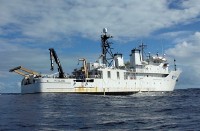|
NWHI
RAMP 2004
 From September 13th, through October 17th 2004, the NOAA (National Oceanic and Atmospheric Administration) research vessel Hi`ialakai ("embracing pathways to the sea," pictured to left), conducted a scientific expedition to the Northwestern Hawaiian Islands. The expedition included Rapid Ecological Assessments (REAs) of reef fish, corals, other invertebrates, and algae; towed diver surveys of fish and benthic (bottom) cover; benthic habitat mapping; and long-term biological and oceanographic monitoring of the coral reef ecosystems of the NWHI. During the expedition, a science writer on board documented the research and monitoring efforts for a general audience with daily journals and special features. You can find a list of participants here, our sail plan here, and daily plans of the day here. See also the Bibliography. From September 13th, through October 17th 2004, the NOAA (National Oceanic and Atmospheric Administration) research vessel Hi`ialakai ("embracing pathways to the sea," pictured to left), conducted a scientific expedition to the Northwestern Hawaiian Islands. The expedition included Rapid Ecological Assessments (REAs) of reef fish, corals, other invertebrates, and algae; towed diver surveys of fish and benthic (bottom) cover; benthic habitat mapping; and long-term biological and oceanographic monitoring of the coral reef ecosystems of the NWHI. During the expedition, a science writer on board documented the research and monitoring efforts for a general audience with daily journals and special features. You can find a list of participants here, our sail plan here, and daily plans of the day here. See also the Bibliography.
Reader Challenges: See our pages on La Perouse and Gardner Pinnacles for challenges posed to the reader, and use the "Ask About It!" link to send your solution. We'll post the most interesting replies on this web site!
Click
on one of the following areas to follow the expedition.
Ship's Logs:
Daily "plan of the day" for operations.
Journals:
Daily
or semi-daily personal journal entries by the particpants
in the expedition.
Interviews:
Interviews with expedition participants, scientists,
vessel crew, educators, etc.
Features:
Highlights or special information such as interesting
discoveries or related research.
The Reef Assessment and Monitoring Program (RAMP) is a multi-agency, multi-year effort that began monitoring the Northwestern Hawaiian Islands (NWHI) in 2000. The program will be expanded to other island chains in the near future.
Funding for the 2004 NWHI Reef Assessment and Monitoring Program Expedition was provided by NOAA. Research permits were granted by the the
U.S. Fish and Wildlife Service, the State of Hawai`i Department of Land and Natural Resources, and the NWHI Coral Reef Ecosystem Reserve. The views expressed on this web site do not necessarily reflect the positions of any of the agencies connected with this project.
 Talk About It! Talk About It!
Estimating fish populations
Asked by Richard from Dare Design on Sep 18, 2004.
How do you measure or estimate populations of fish in such a large area as the NWHI?
Answered by Craig Musburger (on the Hi`ialakai) on Sep 20, 2004.
The fish scientists on the NOWRAMP team face the same problem in estimating fish populations in the NWHI as any scientist faces when trying to work with such a large area. Since it is not possible to survey every square inch of the reef up here, we are forced to take samples of representative areas. We have two methods we use to take
these samples. First, we have a "Tow Team" that consists of two divers being towed behind a small boat who count all the large fish they see as they cover a considerable amount of area. They also make an attempt to classify the habitat types they encounter so we can estimate how much area is made up of the various different habitats. Second, we have the Fish REA (Rapid Ecological Assessment) Team which consists of 3 divers that make a much finer scale analysis of each and every fish they see within a smaller area. They identify, count, and estimate the size of every fish seen within a fixed area to try to get an estimate of the types and amounts of every species of fish per unit area. By combining the efforts of these two teams, we can then make large-scale estimations of the fish populations in the NWHI. Hope this helps answer your question. |